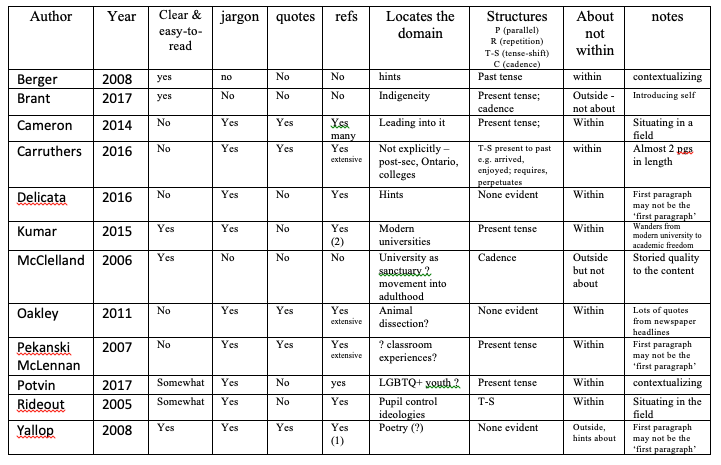First Sentence, First Paragraph
This is a reading response for the first discussions in the Research Colloquium course. The first reading that caught my attention was Leggo (2002) What is good writing? In the first sentence of the article, the author describes himself as a wounded writer. He describes valuing writing in the evaluation process, and writing with desire. From this article, I created a word cloud to capture the 118 words used to describe good writing. As I read each word, I envisioned how these related to my own academic writing. I selected words that resonated with me and then increased their prominence in the word cloud image, created using Word Art.

While reading The Art and Structure of a First Paragraph by Kilbourn (2001), I became intrigued to investigate how PhD dissertations are framed in the first sentence and first paragraph. This resulted in a mini-inquiry and exploration using NVivo software – a bit of coding and collection of first sentences and first paragraphs thanks to my play-time using NVivo software. I imported the PDF files from each of the dissertations that we will be reading in the coming weeks into NVivo software, then coded the first sentence from each thesis as well as the first paragraph. This allowed me to examine them for comparison by contrasting content and writing style. I considered the 6+1 Writing Traits used by teachers in primary classrooms that identify the ideas, organization, voice, word choice, sentence fluency, conventions, and presentation. (for definitions see this Scholastic page and What are the Writing Traits).
I decided to compare first sentences and paragraphs against the qualities outlined by Kilbourn (2001). Some interesting insights can be gained in this exercise. Kilbourn (2001) states the function of the first sentence should be obvious. In its simplicity, the first sentence should not overwhelm the reader yet provide information such as the domain of the inquiry. The first paragraph can include techniques such as “parallel structure, cadence, repetition, and tense-shifting” while communicating clearly (Kilbourn, 2001, p. 1). It should be “about the thesis, not within it”. Here’s a chart outlining what I’ve discovered:

This chart was easier to create without having read each of the dissertations. I purposefully did not read the abstracts so had little idea about the dissertation or research other than information gleaned from the titles. Thus, I had a more clinical and outsider view of the topic and writer.
About half of the first paragraphs were easy to read and jargon free. Only three out of the 12 paragraphs had no quotes or references included, making them easier to understand. None of these first paragraphs followed Kilbourne’s suggestion to “be about the thesis, not within it”.
After reading each of these first paragraphs, and trying to decipher the tone, author’s voice, and organization of ideas within the text, the challenge of writing a first paragraph illuminates the “myopia” that can overtake a researcher as they attempt to help readers see what their research is about (Kilbourn, 2001). It’s less about strategy and structure, and more about beauty and meaning. The paragraphs that drew me into the research were invitational and glimpsed at the person as author and researcher, those paragraphs that fired the imagination of what was to come. Just as reflected in the words that describe good writing as I identified from Leggo’s (2002) good writing word list, those paragraphs that were open, inviting, joyful, courageous, vivid and fluid were the ones that resonated with me.
References:
Kilbourn, B. (2001). The art and structure of a first paragraph. Teachers College Record Online.
Leggo, C. (2002). What is good writing? Grammar and my grandmother. Inkshed, 19(3)